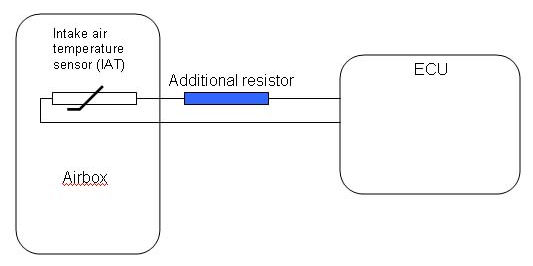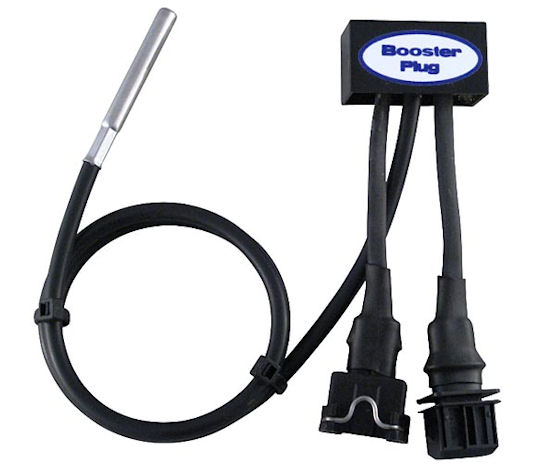BMW Motorcycle ‘Performance’ or ‘Boost’ Modules – Resistor Tuning
BMW Boxer Engined Motorcycles – Performance ‘Boost’ Devices
Article by ukGSer ‘Ebbo’ (Martin)
Check out Martin’s website www.ebbo.org for more articles by him on his BMW R1200RT (and R1100RT), trip reports and lots of other stuff 😉
Martin refers to the 1200RT but the article applies equally well to the R1200GS and other R1200 series BMW motorcycles.
Note from the author (Ebbo) re BMW Motorcycle IAT Resistance Tuning / Performance Boost devices comparison, 10Mar2010 – This is a subject I do intend following up with more information, but it’s going to take a while to collate and prove it’s correct, I don’t publish anything I’m not really certain of myself.
Resistor Tuning
Simple devices to improve your motorcycles running
Created by ‘Ebbo’ 05/12/09 – Updated 19/01/10
Lean times
Ever since the 1100 series Oilhead BMW’s came out they’ve suffered from lean fuelling to meet emissions regulations, the trouble is they’re fuelled so lean they don’t really run that well, especially around town where my 1200RT stumbles on and off the throttle and generally gives an unsatisfactory ride. Previously there’d been no cheap and easy ways to improve this but recently new devices have become available that can enrich the mixture to improve acceleration and smooth running in general.
The way these devices work is to modify the signal the ECU gets from the intake air temperature (IAT) sensor. By adding an additional resistor in to the IAT circuit the ECU can be fooled in to thinking the incoming air is colder than it actual is, this causes the ECU to increase the fuel being injected to match the denser, colder air it’s expecting, and that’s just what we want to improve running. And while the ECU monitors the AIT all the time, if the throttle is held steady for a while the lambda sensor comes into play and fuelling will be modified to lean burn, In theory we now have the best of both worlds, extra fuel when we want it and lean running when we don’t.

Temperature compensation
Ideally we want the same amount of additional fuel at all times, unfortunately just adding a serial resistor won’t give us that ‘due to the none linear characteristics of the bike’s IAT sensor. With 20c as a starting point, as the air temperature drops toward 0.c the ECU will progressively reduce the additional fuel it was providing by nearly half. Conversely, as the temperature rises toward 40c it will nearly double. This ‘error’ can be ‘tuned out’ to a large extent by use of an additional NTC resistor and circuitry, exactly how effective that ‘compensation’ is depends on the individual design of the device.
Resistor tuner roundup.
Here I’m looking at five resistor tuning devices I know of, they all plug in-line with the bikes IAT sensor in the airbox and all do a similar job.
1. ‘Accelerator’ module
It looks like two plugs and a piece of wire, but there are components hidden in the plugs including an NTC resistor for temperature compensation. This is the one I currently have on my BMW R1200RT, read below what I thought of the bike’s performance after fitting it.
“Once the bikes fully warmed up riding around town I really noticed a difference. Almost all the lumpiness has gone and it will run down to 1500rpm in 2nd and gently accelerate from there easily, no-way would it have done that before. I never felt compelled to feather the clutch or coast with the clutch in because of lumpiness as it’s so much smoother now. I can well imagine it could lead to less fuel being used because I was often riding the bike in a higher gear and lower rpm than I’d normally have used. It just seems to have made the whole bike sweeter to ride around town, and that’s just what I wanted.”
Available for 1100 / 1150 / 1200 series BMW’s
Cost: €32 inc postage and packing – see here for more info

2. BoosterPlug
I really like this one as it has a remote NTC resistor for temperature compensation on a .6m extension cable so you can position it away from the hot engine area. It’s designed to increase fuelling by 6% during acceleration and across most ambient temperatures your ever likely to ride in. I recommend you read the makers website for more information as it’s described in excellent detail.
Available for a large range of BMW motorcycles (purchased, awaiting testing on my bike). Cost: $150 inc postage and packing – Click here for makers website

3. ReCyclizer
Not tried by me but I’m advised by the makers it does use a NTC resistor for temperature compensation.
Available for BMW R1100 / R1150 / R1200 inc R1200GS motorcycles.
Cost: €35 inc postage and packing – Click here for makers website

4. MemJet
An adjustable resistor tuner. This devices could work quite well, but you will have to find for yourself what setting is best, and you may need to tweak that setting a little if the temperature changes significantly. Not tried by me.
Available for numerous models and makes of motorcycles.
Cost $198 – Click here for makers website

5. Power FRK
A hugely expensive resistor tuner for which the manufacturer makes big claims… What’s inside it nobody knows for sure, though I have seen an x-ray showing a circuit board and various components. There is lots of talk on various motorcycle forums doubting this devices does all it claims, basically it’s silly money for a ‘simple’ resistor tuner. Not tried by me.
Available for numerous models and makes of motorcycles.
Cost;$322 ($293 in a current sale) – Click here for makers website

Fitting / Installation
All these devices fit in basically the same way. You remove the electrical connection to the IAT on your air filter box and plug the device in line between the cable you’ve just unplugged and the IAT, nothing could be simpler. The only difference is the BoosterPlug which additionally requires the external temperature probe fixing somewhere where it isn’t influenced by engine heat.

Location of the electrical connector for the IAT sensor on the R1200RT, with panelling removed, left side under the rear of the fuel tank.
Acronyms used
IAT Sensor (Incoming Air temperature Sensor). A sensor for the ECU to monitor air temperature.
NTC Resistor (negative temperature coefficient resistor). A type of resistor whose resistance varies with temperature exhibiting a ‘negative temperature coefficient’, meaning as it gets colder its resistance goes higher.
ECU (electronic control unit). The motorcycles electronic brain which manages the fuel injection and engine management..
A little more reading on modules, chips and resistor tuning for cars here:
IAT Resistor Mods vs Performance Modules vs Real Chips
A German page on simple homemade resistor tuning but with no temperature compensation here: Resistance tuning – BMW R1200GS
My thanks to ukGSer ‘Yonkyo’ who first tried the Accelerator module on the UKGS’ers forum bringing it to our attention and also Jens Lyck for technical advice.
Ebbo
Many thanks to Martin ‘Ebbo’ for the above article – personally [AndyW] I’ve not tried any of these ‘performance boosting’ modules as some time ago I installed a DynoJet Power Commander PCIII on my 2005 R1200GS. The PCIII is another ‘expensive’ solution (although I got lucky picking one up on eBay for less than half price!) but brings the benefit of the very longstanding experience and knowledge of DynoJet and the ability to make tiny adjustments to fuelling across the full throttle range. I used one of DynoJet’s setup ‘fuelling maps’ initially (CAT removed, full Remus exhaust system, K&N air filter) but really noticed the difference after having it set up on a dyno. Really smooth throttle response, no low rpm/constant throttle hesitation (rough running), very noticeable increase in torque at low revs with the engine pulling strongly and smoothly from lower rpm than ever before……..AND my seat of the pants dyno detects lots more power, the engine feels to spin up much more enthusiastically and pulls like a train from the get go 🙂

BMW R1200GS IAT sensor connector location

Thanks for the article, very informative, is the fitting the same on an r1150rt my bike would benefit greatly
Thanks In advance